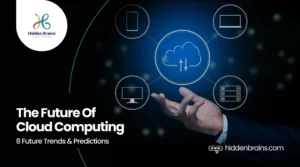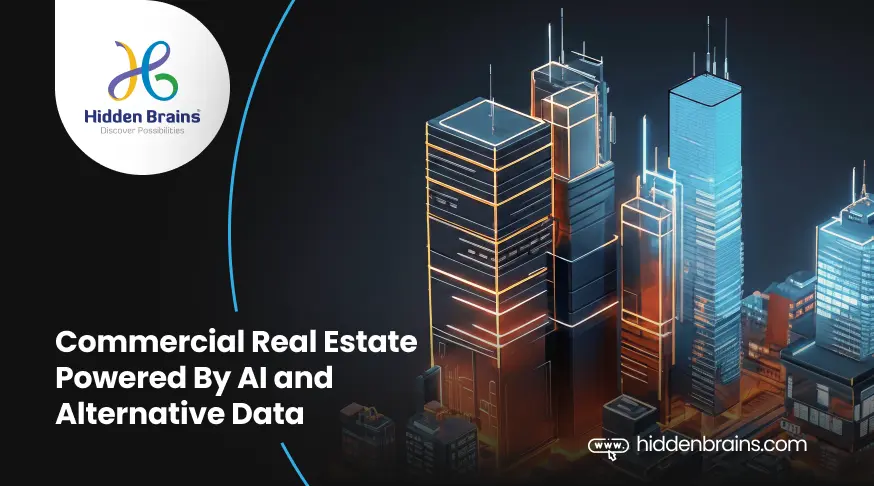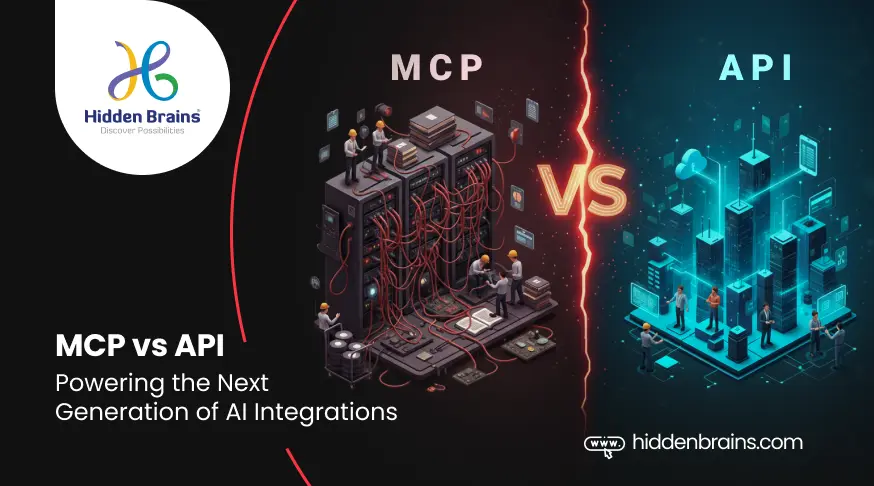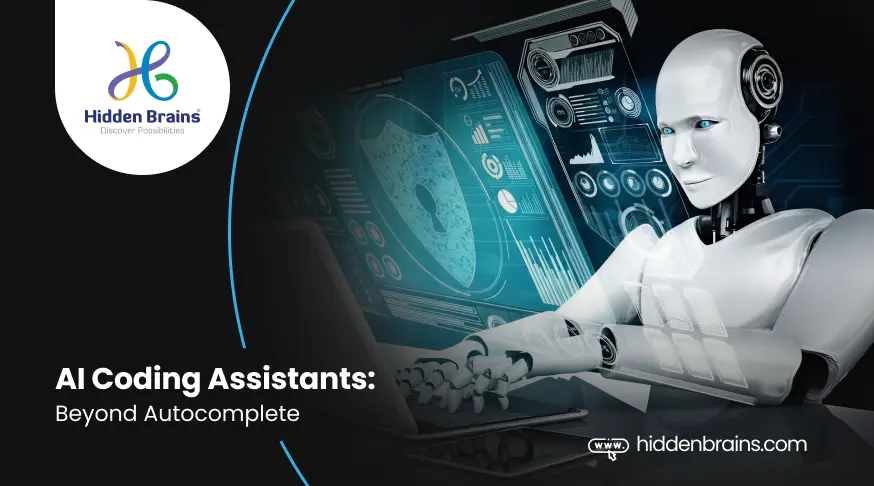Quick Overview
Imagine computing where your data lives, exactly where it makes the most impact; clouds evolving, adapting, and anticipating the next wave of possibilities. This blog maps out that horizon: it begins with a snapshot of cloud computing: SaaS, PaaS, and IaaS and explores its defining features like scalability, resource pooling, and pay-as-you-go models. It then dives into the benefits fueling cloud adoption and lays out eight future trends: edge computing, AI integration, multi-cloud environments, smarter storage, containerization, IoT acceleration, rising costs, and query optimization. The post shows how Hidden Brains helps firms navigate this evolving landscape, before closing with key takeaways and foresight.
The story of building complex, data-driven, and innovative solutions is incomplete without the presence of cloud computing technologies. The cutting-edge web and mobile apps we use today may not have the desired scalability or may be costly to develop in the first place. According to many experts, the surge in mobile and web applications is due to the advancement in cloud computing. The future of cloud computing will determine the organizations’ ability to craft innovative and future-ready tech solutions.
According to Fortune Business Insights, in 2024, the cloud computing market size will reach $676.29 billion from $587.78 billion. The same report projected that it will maintain this phenomenal speed, and the market size will be valued at $2291.59 billion by 2032.
The emergence of artificial intelligence has made the innovations around the future of cloud computing more interesting. If you are interested in knowing more about Cloud computing, its benefits, and a few future trends and predictions of cloud computing, this blog is for you.
You may also like to read: Why Do Enterprises Need Cloud Transformation?
What Is Cloud Computing? – Snapshot
Cloud computing is a technology that facilitates the delivery and access of computing services to users. The technology has three main layers. Let’s discuss these three layers in greater depth.
- Cloud-based Software (SaaS): Cloud-based software, also commonly known as software as a Service (SaaS), offers users an opportunity to access applications from anywhere without installing them locally. Leading email services, customer relationship management tools, and collaboration platforms like Microsoft 365 and Google Workspace are the prime examples of SaaS or Cloud-based software.
- Cloud-focused Infrastructure (IaaS): Cloud-focused Infrastructure, popularly known as Infrastructure as a Service (IaaS), provides users with the essential hardware, tools, and resources necessary for cloud computing. IaaS has servers, storage, and critical networking components. Cloud service providers such as AWS, Microsoft Azure, or Google Cloud host and manage these components and offer users subscription-based models to use them.
- Cloud Platforms (PaaS): Cloud platforms, also known as Platform as a Service (PaaS), provide the most complete environment for developers — an all-encompassing space to build, deploy and run applications. They offer the tools and framework, as well as services like databases, APIs, and runtimes, that developers need to write code without managing all underlying infrastructure. Heroku, Google App Engine, and AWS Elastic Beanstalk are some examples.
These components enable a technology ecosystem that transforms how businesses and individuals use technology. SaaS levels the playing field for organizations to use and evolve applications quickly based on changing needs when significant up-front app costs can prevent this change. IaaS delivers the scale and flexibility your enterprise needs to access a mainframe environment to solve vertical scale problems cost-effectively, ranging from scaling availability to managing massive data workloads. On the other hand, PaaS incubates innovation by liberating developers from being infrastructure engineers.
These layers drive digital transformation, foster agility, and enable organizations to remain competitive in an ever-evolving technological landscape. Businesses no longer need to build and maintain physical infrastructure to create, manage, or maintain application-based solutions. You can rent computing resources from popular cloud providers like AWS, Azure, and Google Cloud.
Key Features of Cloud Computing Technologies
Organizations can innovate and operate more flexibly and efficiently through transformation by Cloud Computing technologies. They allow businesses to tap into on-demand resources with no upfront costs and operational simplicity, obviating expensive infrastructure investments. Cloud technologies help achieve faster scaling, adaptations to market changes, and more incredible innovation using the latest tools & services.

Now, let’s check out the critical features of Cloud Computing technologies
1. On-Demand Self-Service for Seamless Accessibility
Cloud computing technologies offer On-Demand Self-Service for Seamless Accessibility, allowing users to access and manage computing resources such as servers, storage, and applications without directly interacting with the service provider.
2. Broad Network Access for Unrestricted Connectivity
Cloud Computing offers broad network access, making it available from anywhere. Any Device allows null connectivity to unrestricted or Unbridled connectivity in a wide network access combined system. It supports the distributed team collaboration feature. Users can log in to main applications or data from laptops, smartphones, or tablets without any hurdles.
3. Optimized & Efficient Resource Pooling
Resource Pooling is one of the base principles of cloud computing, where providers provide a multi-tenant model to dynamically assign and automate the computing resource. Cloud makes things efficient and cost-effective for the user by pooling resources like storage, processing power, and memory.
Resources: assigned to customers on demand in a location-agnostic yet secure and privacy-preserving way. Incorporating cloud cost optimization strategies further enhances this efficiency, ensuring that organizations maximize performance while minimizing unnecessary spending.
4. Scalability for Business Agility
Scalability empowers organizations to adjust their computing resources seamlessly in response to changing demands. Cloud computing provides unmatched flexibility, whether scaling up to handle sudden traffic spikes or scaling down during quieter periods. This elasticity ensures optimal performance while minimizing costs, as businesses can expand or reduce resource allocation without delays or hardware constraints.
5. Pay-As-You-Go Pricing Model
Pay-as-you-go will change how any business manages IT expenses in the market with a consumption-based pricing model. This model reduces wastage and allows companies only to pay for what they need, making cloud computing an affordable option for businesses of all sizes. It helps enforce better budget planning and resource management for organizations.
You may also like to read Cloud, Big Data, & DevOps In The Enterprise
Benefits of Cloud Computing
With cloud computing, businesses can operate more efficiently while scaling up their tech solutions. Cloud computing allows businesses to operate online seamlessly without investing any huge money. Cloud computing offers a wide range of benefits. Learning these benefits will help us better understand the future of cloud computing.
- Cost-Effective: Although we do argue with the cloud as the IT domain, the cloud sector can be even more affordable to a data-driven business because organizations pay for resources consumed, avoiding the cost of sizeable initial hardware and infrastructure investments. It is a pay-as-you-go model that minimizes operational costs, even more economical for small and medium-sized enterprises.
- Scalability: As cloud organizations offered services that could be elastic and scalable, they would be able to adapt to changing business needs. By adjusting to these traffic extremes, such as divesting in periods of low traffic and scaling up during peak demand, cloud computing enables businesses to maximize business resources and prevents overprovisioning. Be it a web-hosting or delivery service, the cloud works best in provisioning resources as per your needs.
- Agility: With cloud-based solutions, you can deploy, access, and manage business resources wherever you go as to access and manage resources from anywhere with an internet connection. This boosts the remote work functionality, increases team collaboration, and promotes stronger business agility.
- Reliability: Cloud providers are heavily invested in redundancy and availability, minimizing downtime. This minimizes data loss risks in service disruptions, consequently enhancing business continuity.
- Security: One of the leading advantages of the Cloud is safeguarding sensitive information. The Cloud consists of encryption, access controls, and regular security audits. It can help businesses improve their overall security posture and reduce the impact of cyber threats.
Cloud Computing Future- Types, Technologies, Real-Life Use Cases, & Leading Platforms
The following table will showcase the various types, technologies, use cases, and leading platforms shaping the future of cloud computing technologies.
| Type of Cloud | Technology | Elements | Use Cases |
| Public Cloud | IaaS, PaaS, SaaS | Virtual machines, storage, databases, networking, development platforms, software applications | Web applications, data storage, big data analytics, software development, CRM, ERP |
| Private Cloud | IaaS, PaaS | Virtual machines, storage, databases, networking, development platforms | Highly sensitive data, regulatory compliance, internal applications |
| Hybrid Cloud | IaaS, PaaS, SaaS | Combination of public and private cloud resources | Disaster recovery, data backup, bursting workloads, compliance requirements |
| Multi-Cloud | IaaS, PaaS, SaaS | Utilization of multiple cloud providers | Optimization, redundancy, avoiding vendor lock-in |
| Serverless Computing | Function as a Service (FaaS) | Event-driven functions, automatic scaling | Real-time data processing, IoT applications, web and mobile backends |
8 Future Trends & Predictions Of Cloud Computing

The technology around cloud computing is rapidly evolving. The inception of artificial intelligence and machine learning has transformed the initial characteristics of cloud computing technology. The following trends and predictions will determine the future of cloud computing technologies for sure.
Trend 1: Edge Computing- Data Processing Will Be Closer To The Source
One of the prominent cloud computing trends is the evolution of edge computing. It will decentralize data processing. Edge computing allows data to be processed closer to where it is generated: at or near the source of data generation, i.e., IoT devices, sensors, or local computer networks rather than cloud servers. This reduces latency, improves real-time processing, and reduces bandwidth costs.
As 5G networks roll out in the coming years, edge computing will remain tightly integrated with cloud services to drive the next-generation smart city, predictive maintenance, or augmented reality experiences.
Trend 2: Higher Adoption Of Hybrid & Multi-Cloud Environments
The discussion around cloud computing trends is incomplete without the implications of hybrid and multi-cloud environments. Predicting the future is where organizations will seek hybrid and multi-cloud. Hybrid architecture provides you with a combination of on-premises and public cloud solutions, which gives you enhanced flexibility along with greater control over security and compliance.
Likewise, multi-cloud strategies enable organizations to use services across several providers, preventing lock-in to a single vendor while allowing access to services that are ideal for their purposes. Over the next several years, tools will simplify multi-cloud management, and interoperability standards will become critical.
Trend 3: Integration Of AI & ML In Cloud Services
Cloud platforms integrate some features of AI and Machine Learning that enable organizations to gain insights and automate things. Automation and Machine Learning: Whether it be cloud-based AI solutions such as AWS SageMaker, Google AI, or Microsoft Azure AI, they can be adopted by organizations of all sizes, democratizing advanced analytics and predictive modeling.
In the long term, AI-enabled cloud systems will predict demand for resources — too much and too little — detect potential outages and establish cybersecurity. Artificial intelligence and the cloud can also amplify the parameters for businesses to drive innovation.
Trend 4: IoT As An Accelerator For Cloud Computing
One of the primary driving forces behind cloud adoption is the Internet of Things (IoT), which refers to the growing network of billions of devices connected to the Internet and generating massive quantities of data that need to be stored, processed, and analyzed. IoT workloads could benefit from scalable infrastructures provided by cloud platforms with end-to-end secure device connectivity and real-time analytics capabilities.
With the rise of IoT opportunities, including smart homes, healthcare, and industrial automation, the need for strong cloud-IoT integrations will only crop up. IoT-based Cloud will become more popular and remain a vital cloud computing trend.
Trend 5: Expansion Of Containerization
The future of cloud computing will witness an expansion of containerization. Technologies such as Docker and Kubernetes have spurred a trend known as containerization that’s changing how applications are developed, deployed, and scaled. By packaging code and dependencies together, containers enable applications to run uniformly in different environments. The portability reduces friction between development and production, speeding up the fallen software delivery cycles.
They facilitate organizations with cluster-wide configuration, scaling, and diverse services, including logging, monitoring, and many other methods. Containers will rule the future of cloud computing as microservices architecture becomes mainstream. Fast adoption across traditionally complex industries in container-native tools and services felt raised support.
Trend 6: Enhanced Data Storage Capabilities & Data Centers’ Energy Efficiency
In response to the exponential increase in data, cloud operators are investing billions in scaling up storage capacity and enhancing power efficiency. Modern data centers are built around new technologies—SSDs, AI-based storage optimization, and hyper-converged infrastructure—to respond to increasing needs. Cloud providers are tackling environmental issues by utilizing renewables and developing energy-efficient cooling systems.
Google, Microsoft, and other companies have set the bar with carbon-neutral efforts. According to future cloud computing trends, sustainability will play a vital role in cloud adoption, as regulatory and consumer pressure will force more eco-friendly solutions.
Trend 7: Cloud May Be Costly In The Future
According to many experts, future trends in cloud computing may have the fear of additional cost burdens. Although cloud computing has typically offered lower infrastructure costs, the increasing market share of the large cloud providers could inspire higher prices as cloud services become bundled with ancillary fees and onerous contracts. After initial contract details, businesses can encounter high data transfer costs, premium pricing for advanced services, and long-term vendor lock-in.
The escalating threat of these risks is compelling organizations to embrace cost-management best practices, including multi-cloud architectures and external cost optimization tools. Price transparency and better competition from new providers may offset these trends, but enterprises must stay alert against unsustainable cost inflation.
Trend 8: Efficient Query Performance Techniques Optimizing Data Stores
With the ever-increasing volumes of data, query performance optimization has become one of the dominant trends in cloud computing. These approaches encompass efficient query performance techniques for rapid accessing, processing, and analyzing large datasets, minimizing latency and computational overhead. To achieve this optimization, Many cloud platforms are implementing new strategies, like queuing with indexing, caching, and smart partitioning of the data.
This is increasingly true for common queries that benefit from parallelization, as cloud providers embrace distributed computing frameworks (e.g., Apache Spark; Presto) that enable queries to be executed across multiple nodes in parallel. Moreover, AI- and ML-based query optimization tools that are emerging have the ability to adjust execution plans on the fly depending on workload patterns to reduce resource consumption and maximize throughput.
How Hidden Brains Can Help You Navigate the Future of Cloud Computing
Are you excited about the future of cloud computing and want to build a scalable cloud computing solution? Hidden Brains is a leader in transforming businesses by making the digital move to the Cloud. It has rich experience in innovating and dominating businesses. With one eye on the processes and one eye on the future, we are your trusted change agent, driving easy processes with easy clouds.
From optimizing existing systems and enabling seamless scalability to designing robust, secure, and future-proof cloud ecosystems, our team delivers a frictionless development experience.
FAQs
What Are The Key Trends Shaping The Future Of Cloud Computing?
Several key trends, including the rise of edge-computing, hybrid, multi-cloud environments, AI & ML Integration, and the growing influence of IoT-based cloud solutions mark the future of cloud computing. In addition, the changing nature of cloud pricing and enhanced cloud storage are also critical future trends in cloud computing.
Why Are Businesses Shifting Toward Hybrid & Multi-Cloud Environments?
Organizations are advancing toward hybrid and multi-cloud environments in huge numbers to add flexibility, minimize reliance on one vendor, and harness the best characteristics of many platforms. Hybrid environments integrate on-premises and cloud infrastructure, guaranteeing compliance and safety, while multi-cloud strategies let companies maximize cost and performance by employing curated applications from various vendors.
How Does Edge-Computing Impact Traditional Cloud Models?
However, edge computing complements traditional cloud models by bringing data processing power to the data source to reduce latency and enhance real-time decision-making. Edge computing decentralizes processing, unlike centralized cloud systems, which is essential for use cases that range from IoT devices to autonomous vehicles and remote healthcare solutions. This trend enables organizations to obtain the best centralized and distributed computing paradigms.
Will Cloud Computing Become More Expensive In The Future?
Despite cloud computing traditionally lowering IT costs, changing pricing models around general providers could make things more expensive due to added expenses, in-depth contracts, and premium pricing for innovative solutions in the 2030s. Multi-cloud strategies, careful negotiation of contracts, and cost optimization tools can help businesses reduce these potential costs and manage their cloud spending.
How Can Businesses Prepare For The Future Of Cloud Computing?
To prepare, businesses can stay informed on emerging trends, invest in cloud-native technologies such as containers and serverless architectures, and leverage AI-driven optimization tools. They must also be flexible in their approach to achieving scalability with the help of hybrid or multi-cloud environments. Bridging the gap with seasoned cloud service providers would help accelerate the transition and leverage maximum benefits from cloud transformation.
Final Words
The future of cloud computing is brimming with transformative possibilities, driven by advancements such as edge computing, hybrid environments, AI integration, IoT acceleration, and enhanced data management techniques. As businesses navigate an increasingly digital landscape, the cloud will remain a cornerstone of innovation, enabling agility, scalability, and resilience.
However, alongside these opportunities lie challenges, such as rising costs and the need for sustainable practices, requiring organizations to adopt strategic and informed approaches. By staying ahead of these trends and embracing the evolving capabilities of cloud technology, businesses can not only meet today’s demands but also position themselves for long-term success in a rapidly changing world.






























































































![Sales & Distribution [Oil & Gas] Sales & Distribution [Oil & Gas]](https://www.hiddenbrains.com/blog/wp-content/themes/blankslate/assets/images/sales_and_distribution-icon.74d08193.svg)

![Fluid Terminal Management [Oil & Gas] Fluid Terminal Management [Oil & Gas]](https://www.hiddenbrains.com/blog/wp-content/themes/blankslate/assets/images/fluid_terminal_management-icon.4b3a27a4.svg)































![Sales & Distribution [Oil & Gas] Sales & Distribution [Oil & Gas]](https://www.hiddenbrains.com/blog/wp-content/themes/blankslate/assets/images/sales_and_distribution-icon.74d08193.svg?1.0.0)
![Fluid Terminal Management [Oil & Gas] Fluid Terminal Management [Oil & Gas]](https://www.hiddenbrains.com/blog/wp-content/themes/blankslate/assets/images/fluid_terminal_management-icon.4b3a27a4.svg?1.0.0)


























































































































































































